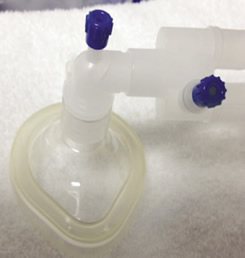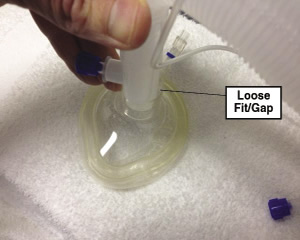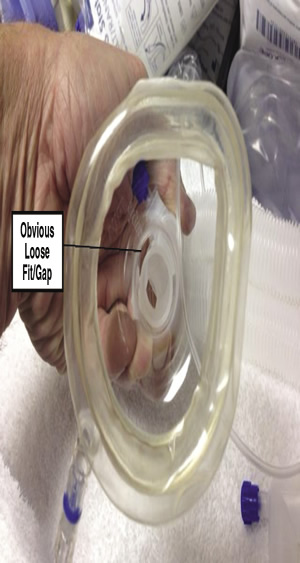Our anesthesia department recently changed to Vital Signs breathing circuits for both adult and pediatric patient populations. There was no noticeable difference between our previous supplier and the Vital Signs circuit for adult circuits. However, a major change in design was noted with the pediatric circuit. When the elbow was removed from the terminal “wye,” it was discovered that the pediatric Vital Signs circuit has an outside diameter of 19 mm instead of the 22 mm of our previous pediatric breathing circuit. An anesthesia provider then attempted to fit the terminal “wye” into the anesthesia mask without success immediately following extubation of the patient. The circuit is packaged with a removable elbow that fits both 15 mm and 22 mm standard fittings. However, if the elbow becomes misplaced, as in our case, the anesthesia provider did not have a means to connect the mask to the “wye.” Please see attached pictures for illustration.
Paul Packard, CRNA Gina Bond, CRNA Hickory, NC
Reply from Vital Signs Devices
Vital Signs Devices appreciates the opportunity to respond to the critical observations made on our pediatric wye piece. To recap, the external terminal connection found on the Vital Signs pediatric wye is not a 22 mm fitting, but instead is a 19 mm fitting. ISO 5356 (2004) for conical fittings directs breathing circuit components to employ either a 15 or 22 mm but does not require fittings to be present on both the internal and external surfaces on a component. The Vital Signs pediatric wye piece uses the 15 mm internal connection.

Figure 1. Proper fit of Vital Signs pediatric circuit with specialized elbow adapter connected to pediatric mask.
For the external diameter, we looked at the use case for the product noting how the anesthesia breathing circuits were oriented, in general terms, parallel to the supine or prone patient. Linear components, like an HME or gas sampling adapters are functional extensions of the wye continuing the circuit’s parallel orientation. A 90° connector like an elbow reorients the connections to accommodate patient interfaces like the facemask, which by design seal against the patient at a perpendicular angle to their connections. Attaching a facemask with 15 or 22 mm connection directly to the fixed wye’s internal or external patient connection would result in a vertical orientation for the distal portion of the circuit tubing, wye piece and any other inline component (e.g. HME). This orientation and the resulting torque on the facemask would make it difficult to obtain and maintain a seal between the facemask and patient. Vital Signs Devices made the determination during the design phase of the pediatric wye to prevent this orientation on the wye, thus preventing direct connections to the mask.

Figure 2. Superior view of loose fit of Vital Signs
pediatric circuitto pediatric mask without specialized elbow adapter. Figure 3. Inferior view of loose fit of pediatric circuit
Figure 3. Inferior view of loose fit of pediatric circuit
to adult mask without specialized elbow adapter.


 Issue PDF
Issue PDF